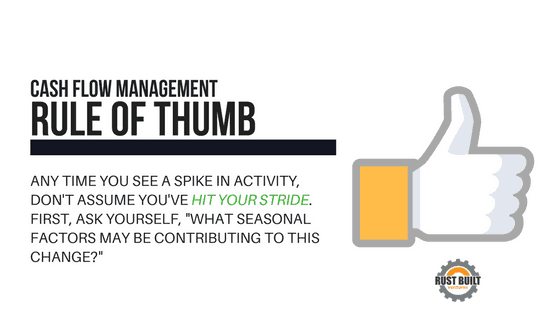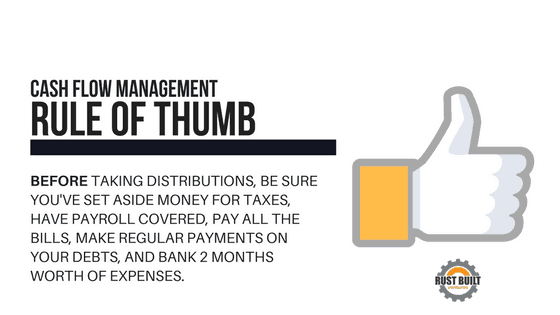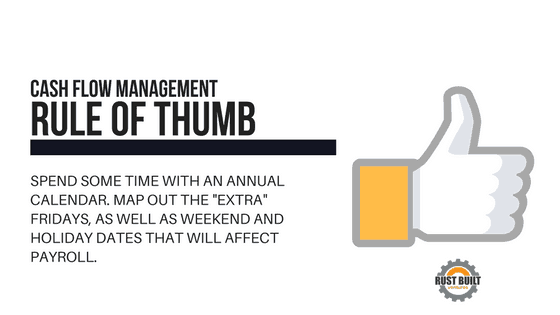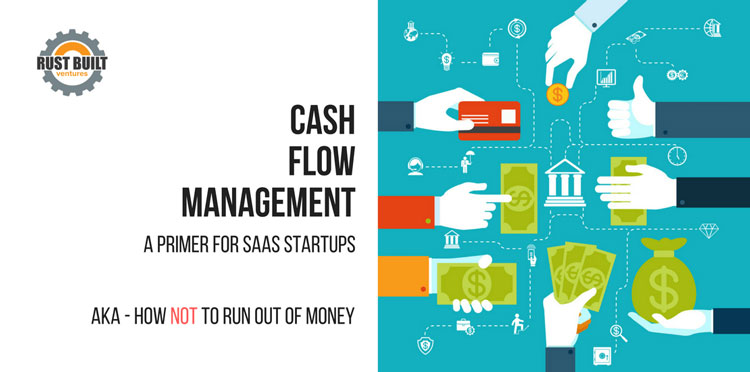How a Profitable SaaS Startup Can Run Out of Cash
(…or not if they focus on cash flow management)
Whether you’ve found yourself in one or not, you know that hitting a cash crunch can be one of the most stressful challenges a growing company can face. Even profitable companies – scratch that – ESPECIALLY profitable, young SaaS companies are susceptible to serious cash problems if they don’t take some time to really understand how the money moves.
Cash Flow vs. P&L
Just because you’re profitable, doesn’t mean you have cash. I know, that sounds crazy, but it’s true.
Profitability means that you’re bringing in more in revenue than you’re spending… over a month, a quarter, or a year. But, it doesn’t mean that you’re going to collect the cash in time to pay your bills. Some expenses may be due before you have the cash in the bank to pay for them, even though you know that cash is coming.
For example, you may be expecting $50k in cash on Tuesday, but if it’s Friday and you’re short $10k for payroll, those four days between now and Tuesday are four days that you’re risking losing your entire business – even though you’ll have a profitable month on the books once Tuesday rolls around.
That’s all thanks to an evil little principle called “cash flow“.
So, I ask that you forget about profitability for a moment and let’s dive into some instances when your cash flow can become a challenge, and talk about how to avoid having these challenges turn into disasters. Let’s look at cash flow management…
Common Pinches on Cash Flow
AR (Accounts Receivable)
If your SaaS has a typical MRR (monthly recurring revenue) model with fees between a few dollars and a few hundred dollars, AR is but a blip. You typically only have one business day (maybe two) between the time your customer’s credit card is run and the moment the cash is deposited into your bank account.
Most of you don’t (and probably shouldn’t) count this as AR.
However, if your SaaS (or any other startup business) charges annual or quarterly fees, calculates usage fees post-usage, collects amounts above $5,000/month, has rates that spike seasonally, or any other situation which has customers asking, “Can you send me an invoice?”, you need to be intimately familiar with your AR and the aging of your AR.
Cash Flow Management Rule of Thumb: If your average AR totals more than your average profit, you should be looking at an AR aging report every day. Every. Single. Day.

Why? If just one client is late in paying their bill, you may not have enough cash on hand to pay your bills.
Your AR aging report should show you how much revenue you’ve booked, but have not collected. It should include the due date for each invoice. It should also include a summary of which clients are current (even though they owe, it’s not past their due date), which clients are 1-30 days, 31-60 days and 61-90 days past due, and finally who is over 90 days past due.
You’ll want to develop KPIs (key performance indicators) around your AR aging report. I suggest:
- 0 over 90 days (ie, nobody should be 90 days past due)
- < 5% over 60 days
- < 10% over 30 days
Whether it’s you, your bookkeeper, a sales agent, or someone you hire specifically for collections, one person should be accountable for reaching the KPIs you set for aging. You can’t rely on simply sending an invoice and hoping that your clients will pay. And you cannot “feel bad” when you have to send a client a past due notice. Create a plan for reminding them that their payment due date is coming up, the due has arrived, the bill is past due, and so on.
If you’ve struggled with collections in the past, you’ll be amazed at what a set of goals (KPIs) and the attention from a dedicated team member will do. As they say, the grass isn’t greener on the other side, it’s greener on the side you water. Water your AR.
Accurately predicting when you’ll receive the cash for outstanding invoices is no easy feat. But, with time and attention to your AR, you’ll be able to forecast with relatively decent accuracy. Then, you’ll easily be able to pay expenses, knowing when the next influx of cash is coming.
Seasonality
While revenue for many SaaS companies is fairly steady with MRR rolling in, every company can review their past performance and spot trends related to seasonality for better cash flow management. You probably won’t see seasonal spikes like retailers do on and around Black Friday, or like flower shops see on Valentine’s Day and Mother’s Day – but you’ll see some peaks and valleys that you need to be aware of and understand.
Not spotting these trends and understanding what’s behind them can lead you to forecast far more acquisitions, and far less churn than you should.
Let’s imagine together… you have a photo editing and printing platform. It has an app with some fun, highly customizable filters. You’ve had a good 10 months of ramping up, you can figure out how many photo orders you’ll receive based on how many apps are installed. You have your paper and printing costs optimized and ready to scale.
All of a sudden, it looks like you’ve hit your stride. Numbers from July to August take a big jump, and an even bigger jump in September.
You use your trusty formula to forecast the number of photo orders you’ll get and the revenue that will bring. You map the upward trend, conservatively of course, and project new app downloads to continue to rise, pushing up orders and revenue through the end of the year. All of that demand is going to take a lot of printing and shipping supplies and a few new, faster printers – so you gear up and wait for the orders to roll in.
But they don’t. In fact, downloads of the app fall drastically into October, going back to levels that looked closer to July than September.
So what happened?
School happened.
School started in August in the South. A few kids had the app, and shared it with their friends who downloaded it. Then, the large majority of kids through the rest of the US went back in September and the same thing happened on a bigger scale. Kids loved the customizable filters and downloaded the app for that alone. They have no interest in printing the photos. Their downloads are not going to turn into revenue, and you’re not going to recoup the investment on the supplies and printers any time soon.
Understanding seasonal trends that affect your business will help you more accurately forecast cash flow. You won’t overestimate revenue and you won’t spend cash you may not quickly recoup.
Cash Flow Management Rule of Thumb: Any time you see a spike in activity, don’t assume you’ve hit your stride. First, ask yourself, “What seasonal factors may be contributing to this change?”

Distributions
Now, I’m going to sound like a total grinch… however, just because you’re turning a profit does not mean it’s safe for you to take money out of the company. Distributions are the very last thing that should be paid out:
1 – Taxes
2 – Payroll
3 – AP (Accounts Payable)
4 – Debt Repayments (not full, but regular payments)
5 – Two Months of Expenses (Banked)
6 – Distributions
As painful as it can be to pay everyone but yourself, and to leave a buffer in your account – you must. Your ability to manage your cash flow, and therefor, the future of your company depends on it.
Let’s say you have a good month, you’ve been waiting a while and think that now is the time that you can safely take out a few thousand dollars. So, you write yourself a check. What do you do with that money? Is it going to sit in a bank account? Probably not. It’s probably going to pay down some personal debt, or buy something nice for yourself or family, or go towards your own personal bills. The point is – once you take that money out of the business, it’s gone.
What happens when next month isn’t as great as the month before? What happens when a big customer is a few days late in paying their invoice next month? What happens when the servers go down and you have to hire a team of contractors to bring them back up? What happens… okay, enough nightmare scenarios. You get the picture.
Don’t test these worst case scenarios. Get to know your cash flow and get good at predicting it (only time will tell if you are!). Then and only then are you ready to consider taking money out.
Cash Flow Management Rule of Thumb: Before taking distributions, be sure you’ve set aside money for taxes, have payroll covered, pay all the bills, make repayments on your debt, and bank 2 months worth of expenses.

Paying Taxes
Here at Rust Built Ventures, we’re big believers in the financial teachings of Greg Crabtree. (You can learn them for yourself in his book, Simple Numbers, Straight Talk, Big Profits! )
One of the foundational principles you’ll learn from Crabtree is to pay your taxes first. A portion of every dollar you earn already belongs to the government. Lamenting that fact, ignoring your tax liability, and waiting until the last minute to calculate and pay your taxes is a recipe for disaster.
So, as you’re mapping out your cash flow, make it a priority to include taxes. Each month, plan on taking cash out of your operating account, and place it into a tax account.
(Please check with your tax professional for your exact amounts!). Most of the companies we work with fall in the 21% bracket. So, we recommend moving 25% of profits into the tax account each month.
Cash Flow Management Rule of Thumb: Put 25% of profits into a “tax” account every month.
Your $100,000 profit – is effectively $75,000 in cash. $25,000 of your hard-earned profits is not yours to spend.
SO many new business owners get tripped up by this. They underestimate how much taxes will be, they don’t properly forecast cashflow and end up simply “hoping” that there will be enough money in their bank account when April 15th rolls around.
Unfortunately, many businesses don’t find enough in their account by the 15th. They end up cutting back on costs, laying off staff, trying to get customers to pay in advance in exchange for deep discounts, attempting to sell assets, putting money back in from their personal accounts (a good reminder that distributions should be last!), and even taking out personal loans just to pay the tax bill.
And here’s the kicker… by the time you’ve reached April, and you realize that you don’t have enough cash to pay last year’s tax liability, you’re ALREADY 25 – 30% the way through the current year. Which means you’re another 25 – 30% further in the hole than you thought you were.
Tax is a critical item in your cash flow calculations. Budget, forecast, and set it aside every month.
Payroll
While it may seem that payroll would be a simply thing to forecast, there are a few unique characteristics to this expense category that make it less straightforward when it comes to your cash flow management.
The first is employer expenses. Much like the first time you receive a paycheck yourself, and sit back wondering, “Who’s FICA, and why is he getting all of my money?” – new employers may be stunned to see how much it costs to pay their employees, and how complicated the calculations are.
The IRS understands that the issue is complex, and put together a 69 page guide – you can grab it here (for the 2017 tax year) if you’d like the details: https://www.irs.gov/pub/irs-pdf/p15.pdf
In general, though, you’ll be responsible for Social Security, Medicare and Unemployment taxes. This can add around 14% to wages. So, you’ll end up with total expenses greater than the employee’s salary/wages. Just keep that in mind as you’re negotiating wages.
The other unique characteristic to be aware of with payroll is where each pay day falls on the monthly calendar. This is true whether payday is every Friday, every other Friday, or twice monthly.
If you’re on a Friday schedule – you need to look at a calendar and determine which months will have more payouts than others. On a weekly schedule, you’ll typically have 4 paydays per month… except when there are 5 Fridays in a month. If you pay every other Friday, you’ll typically have 2 paydays per month… except when there are 3 Fridays in one month that hit your schedule.
Don’t let that surprise you. Future dates already exist… into infinity. Look at a calendar, count out your weeks, and put the payouts into your cash flow management calculations.
Because banks still think it is the stone age, and insist that there is no way to operate 24/7, those of you who pay twice a month – on the 15th and 30th (or 1st) – you’ll need to plan for paydays that come 2 or more days in advance.
For example, if the 15th is on a Sunday, your payroll will run on Friday. That’s two days earlier, aka, two less days of revenue collection to meet that payroll.
Now… this is further complicated by “bank holidays”, especially when they fall on either side of the weekend.
So, if the 30th happens to fall on the last Monday in May, your payroll will actually need to be funded be 3 days earlier in order to go out by Friday.
(Bank holidays can also affect Friday paydays.)
Also – if you’re using a payroll processing service (like PayChex or Gusto) be aware of how many days in advance your payroll will need to be funded. This can bump the pinch on your cash up a few more days. Most of these service require that you have your payroll funded 2-3 days prior to payday. So, Friday payroll may need to be completely funded by Wednesday. Or, that Monday the 30th payroll that falls on a holiday, and needs to be paid out by Friday, may need to be funded by Wednesday… cutting almost a week out of your cash collections.
Again, you have access to an eternity worth of future dates. These occurrences shouldn’t surprise you. Plan for them in your cash flow management calculations and you’ll be sure to have the cash on hand to make payroll.
Cash Flow Management Rule of Thumb: Spend some time with an annual calendar. Map out the “extra” Fridays, and the weekend and holiday dates that will affect payroll.

Can You Accurately Predict Your Cash Flow?
So, you’ve probably spent a lot of time predicting your profits based on revenue and expenses – but I’m hoping you now see that you need to spend just as much (if not more) time on predicting your cash flow.
If you’re struggling to get your arms around cash flow, we’d love to help. Whether it’s a few months of coaching you through some processes and spreadsheet formulas, or a 3 day financial “come to Jesus” workshop, we can help you develop a cash flow management strategy to make sound decisions with your profitable startup.

